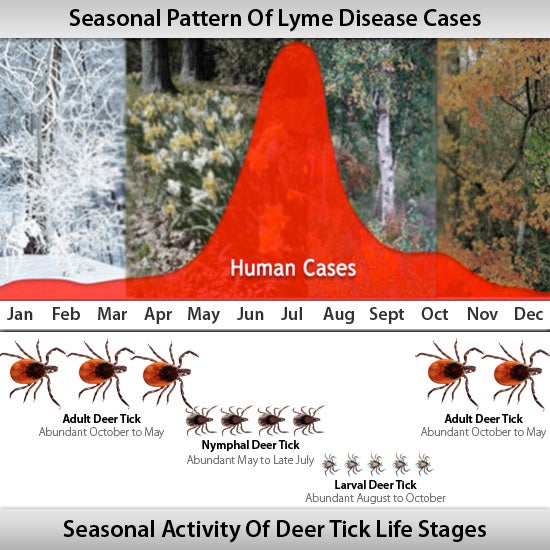Just when you thought that the bloodsuckers of summer should be gone, some come back. TICKS. That’s right! Not all types … but one type that’s especially dangerous – adult blacklegged ticks. Rather than being killed off by cooler nighttime temperatures — even a frost or a freeze — adult blacklegged tick populations are just rev-ving up, and they can strike … well, like a Ticknado! And similar to being prepared for any other natural disaster, NOW is when you should have your tick bite protection toolkit ready and implemented.
Asking why these ticks wait until fall to emerge is like asking why hurricane season runs from June to October. There’s a season for everything, including a season for each and every type and feeding stage of tick. Here’s how it goes: the youngest stage of blacklegged ticks, called larvae, hatch from eggs in June but take a month or so to “get hungry”. So they’re actively blood sucking in August and September. They take the fall and winter to transform into nymphs, and then that stage emerges, in late May (in record numbers this past year). Nymphs seek blood meals thru June and July, and if successful, take a month or more to transform into adult males and females. Another month or so passes while they get hungry, putting them right on schedule to display their blood lust by October.

It’s hard to say what the evolutionary forces might have been to develop such a cycle. Deer, which are the main reproductive hosts for adult blacklegged ticks, are more active in the fall when they’re in rut. This increased activity of suitable hosts does conveniently increase opportunities for adult stage ticks to latch on as these hosts wander by. Maybe that’s a reason. This seasonal activity pattern may be related to selective advantages favoring one of the earlier life stages, too.
While asking “why” can make for some interesting speculation, asking “what now” is really more important. Adult blacklegged ticks are loaded with pathogens – more than 50% are likely carrying Lyme disease bacteria in much of their range. And don’t forget about anaplasmosis and babesiosis, too, ’cause these ticks can be packing those pathogens as well. When October comes and there’s a chill in the air, check your TickBite Protection Checklist often to always Be TickSmart! Stay TickSafe!
